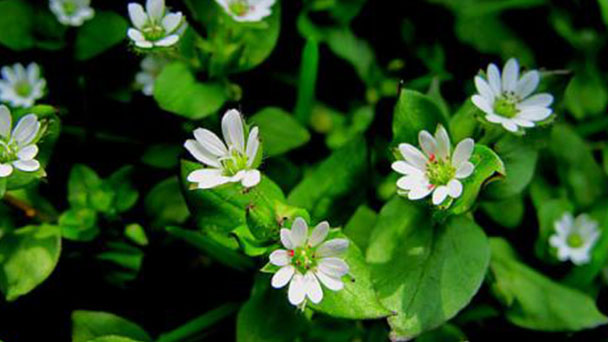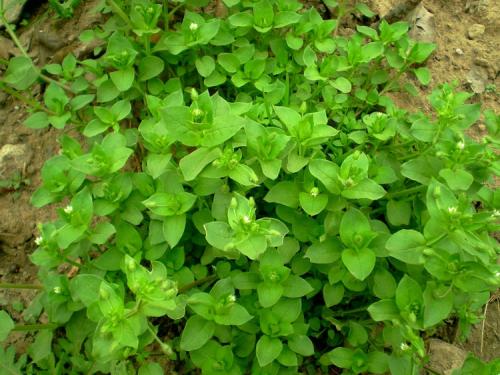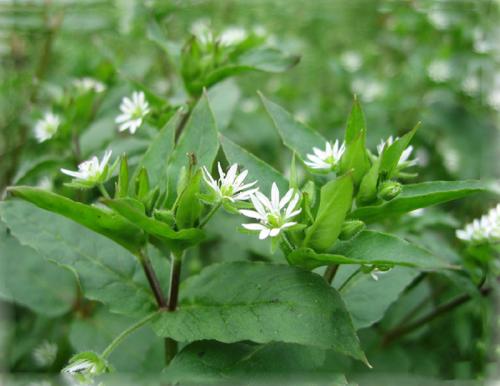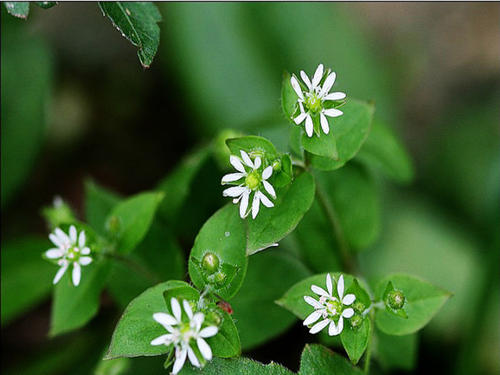Chickweed (Stellaria media) profile
Written by Maggie
Mar 11 2021

Chickweed (Stellaria media) is a common field weed of the Dianthus family and Chickweed genus, annual or biennial herbs, with a height of 10-30 cm. Chickweed stems are tilted or ascending, more or less branched at the base. Chickweed prefers mild humid environments, Yunnan generally grows vigorously in the rainy season, and can also be seen in winter. The suitable growth temperature is 13 ~ 23℃, and can adapt to light frost.
Chickweed is distributed in temperate regions, in the range of 500 ~ 3700m in the middle and low altitude and middle and high altitude areas of Yunnan, mainly on the hillside, under the forest, near the field and along the road.
Chickweed picture

Morphological characteristics of chickweed
Chickweed is an annual or biennial herb, 10-30 cm tall. Stem is tilted or ascending, more or less branched at base, often lavender-red, 1 (-2) hairy. Leaf blade is broadly ovate or ovate, 1.5 -- 2.5 cm long, 1.1 -- 1.5 cm wide, apically acuminate or acute, base attenuate or subcordate, entire; Basal leaves are long petiolate, upper leaves often sessile or shortly petiolate.
Inflorescence of Chickweed is sparsely terminal; Pedicels are slender, with a row of short hairs, elongated after anthesis, pendulous, 7 -- 14 mm long; Chickweed has sepals, ovate-lanceolate, ca. 4 mm long, tip slightly obtuse or suborbicular, margin broadly membranous, outer covered with short glandular hairs; Petals are white, long elliptic, shorter than sepals, deep 2-lobed to base, lobes sublinear; Chickweed has 3-5 stamens, shorter than petals; Chickweed has 3 styles, linear.
Capsule of Chickweed is ovate, slightly longer than persistent calyx, apical 6-lobed, with many seeds; Seeds are ovoid to suborbicular, slightly oblate, reddish-brown, 1-1.2 mm in diam., surface with hemispheres nodules, ridges more pronounced.
Stems
Stem of Chickweed is prostate slender, giving birth on the section most upright, branch cylindrical, succulent and crisp, break hollow, stem table a side has a line of pubescent, the rest part is hairless.
Leaf
Leaves of Chickweed are simple opposite; Upper leaf is sessile, lower leaf sessile; Leaf blade is ovoid or ovate, 1.5 -- 2.5cm long, 1 -- 1.5cm wide, apex acute or mucronate, base subtruncate or shallowly cordate, entire or undulate, glabrous on both surfaces.
Flowers
Flowers of Chickweed are bisexual; Flowers are solitary branches axillary or terminal cymes, pedicels slender, hairy on one side; Equal slice 5, drapery shape, white short glandular hair outside, margin dry membranous; Chickweed has 5 petals, white, shorter than calyx, 2-lobed to base; Chickweed has 10 stamens, anthers purplish red and then blue; Ovary is ovate, style 3-4.
Fruit capsule ovate, apex 6-lobed.
Seeds
Seeds of Chickweed are numerous, black brown; The surface is densely verrucous with small protrusions.
Ecological habits of chickweed
Chickweed likes mild and humid environments. Generally, it grows well in the rainy season in Yunnan and can also be seen in winter. The suitable growth temperature is 13 ~ 23℃, and can adapt to light frost.
Chickweed is distributed in temperate regions, in the range of 500 ~ 3700m in the middle and low altitude and middle and high altitude areas of Yunnan, mainly on the hillside, under the forest, near the field and along the road.
The way chickweed propagates
Chickweed is an extremely prolific plant, filled with white star-shaped flowers and scattered with tens of thousands or even millions of seeds all year round.
Disease control of chickweed
Chickweed is a malignant weed in summer crop fields in China, especially in low-lying fields, which occurs in all summer crop fields in China. The Yangtze River basin is the main area of the occurrence and damage. Serious damage was reported in the northern part of South China and Southwest China. In addition, there were also reports in North China and Northeast China, but the damage was not serious.
The main characteristic of Chickweed harm is that in the early stage of crop growth, it competes with crops for water, fertilizer, space and sunshine.In the later stages of crop growth, rapid creep and hinder crop harvesting, especially mechanical harvesting.
Chickweed can be treated with ipranone for soil treatment, and can also be treated with herbicide for stem and leaf treatment in later stages. Wheat field Chickweed (cattle Chickweed) can also be treated with ipranon. In addition, the stem and leaf treatment agents, such as phenylsulfuron, chlorofluropyroacetic acid, 2 methylene 4 chloride, metasone, zoloxone, chlorofluroxane, bromophenonitrile and their mixes, as well as difluorozozopyrimethamine (meici) and sulfamide (preferred), which were suitable for controlling broad-leaved weeds in wheat field, all showed different degree of control effect on Chickweed and bovine Chickweed. In recent years, wheat field Chickweed and cattle Chickweed in middle Jiangsu and other places developed strong resistance to benzulonon, and the control effect decreased after using the drug. Chickweed was very resistant to zoloxone, and cattle Chickweed was also very resistant to zoloxone.
Fine field management, timely plowing and weeding. Drug control can catch grass net, special factory net, with the ground, catch out net, glyphosate, broadleaf net, baicao enemy, 2, 4 drops + baicao enemy, etc..

A taxonomy of Chickweed varieties
World of Chickweed: 120 species;China: 57 species
All species
Alishan Chickweed
Short trap Chickweed
White hairs Chickweed
Turnip weed
The south Tibetan Chickweed
Chickweed fork disambiguation
Cross Chickweed(original variety)
Long disc Chickweed
Long Chickweed(Original Variety)
Long crack Chickweed
Turnip green grass
Leaf Chickweed
Long Leafed Chickweed(Original Variety)
Evergreen Chickweed
Wrong that Chickweed
Big leaf Chickweed
List Chickweed
The Chickweed distribution area
Chickweed is widely distributed in Yunnan, other provinces and regions of China. It can be seen in Japan, Korea and Russia. Chickweed is a common field weed in China (only Xinjiang and Heilongjiang have not been recorded for the time being), and is also widely distributed in the world.
Chickweed grows in the area of 300 m to 3,900 m above sea level in the world and in the whole country of mainland China. It grows as a weed in the field and has not been artificially introduced and cultivated.
How to control chickweed
The best way to control chickweed is by pulling as much of it out of the ground as possible by hand. Both species have shallow roots and can be easily removed by hoeing or hand pulling. However, since new plants can develop from mouse-ear rootstock, removing the entire plant is how to kill chickweed.
Uses of Chickweed
Medicinal value
Chickweed can clear heat and detoxify, remove blood stasis and relieve pain, and prolactin. For enteritis, dysentery, hepatitis, appendicitis, postpartum blood stasis, abdominal pain, uterine contraction pain, toothache, early gray hair, no milk, mastitis, injuries, sores swelling poison.
Feed effect
Chickweed can be used as wild vegetables and fodder; Chickweed can also be medicinal, internal drive wind, detoxification, external application treatment of sores, fresh seedlings pounding juice, galactagogue effect.
Chickweed stem is fine and soft, but the vitality is strong, there is no artificial cultivation, vegetable field side propagation fast, rarely see its infection disease, the stem and leaves for grass green, so its appearance of good commercial property, feeling very "soft", is a kind of very popular with consumers without pollution, high quality of wild vegetables.
Chickweed is a poisonous plant included in China Plant Atlas Database. Its toxicity is poisonous to seeds, stems and leaves. Cattle, sheep and other livestock after a large amount of food in the gastrointestinal tract, Chickweeds are easy to ferment and form lumps, so there are a series of corresponding symptoms such as abdominal distention and abdominal pain.

Latest Updated
- Benefits of Bugleweed - 7 Science-backed Health Benefits
- Bugleweed Dangers & Side Effects - Is It Poisonous?
- How to Plant Evergreen Trees - What You Should Know
- When to Plant Evergreens - Grow Guide for Evergreen Trees
- 12 Wonderful Evergreen Shrubs for Your Garden
- 12 Popular Evergreen Plants with Pictures for Beginners
- When And How To Prune A Lilac Bush Like a Pro
- How to Grow & Care for Lilac Vine (Hardenbergia Violacea)
- Japanese Lilac Tree (Syringa Reticulata) Care & Propagation Guide
- Shumard Oak Pros and Cons - What to Know
Popular Articles
- Winter maintenance of Antirrhinum Majus
- How to Grow Terminalia Mantaly Tree
- How to Grow and Care for Crossostephium Chinense
- How to grow Antirrhinum Majus in spring
- Peristeria Elata (Dove Orchid) Profile: Info & Care Guide
- Underwatered Snake Plant (Sansevieria Trifasciata) - Signs And How To Fix
- How to Care for Brazilian Jasmine Plant (Mandevilla Sanderi)
- How to Grow & Care for Graptopetalum Purple Delight in Summer
- Rosa Chinensis (China Rose): Plant Growing & Care Tips
- How to Care for Baby Sun Rose (Aptenia Cordifolia)